September 2008 LIP of the Month
Corresponds to event #107 in LIP record database.
The 1.27 Ga Mackenzie Large Igneous Province and Muskox layered intrusion
James M.D. Day Department of Geology, University of Maryland, College Park, MD 20740, USA
e-mail: jamesday@umd.edu
Abstract
The Mackenzie large igneous province (LIP) comprises the Mackenzie dyke swarm, Coppermine continental flood basalts, numerous sill complexes and unexposed magma chambers, and the Muskox mafic-ultramafic intrusion. Study of isotopic and compositional variations within the Muskox intrusion stratigraphy (Day et al. 2008) highlights the complex interactions that occur in LIP plumbing systems feeding continental flood basalts and dyke swarms.
Anatomy of an ancient giant – the Mackenzie LIP
Even by large igneous province standards (e.g., Coffin and Eldholm, 1994, 2005; Bryan and Ernst 2008), the mid-Proterozoic Mackenzie intraplate magmatic event is enormous (Fig. 1). To give an idea of the size of the Mackenzie LIP, the dyke swarm alone covers an area of ~2.7×106 km2 (Fahrig, 1987; Ernst et al., 1995; Baragar et al., 1996); an area greater than that of the Ontong Java Plateau (Fitton et al., 2004), or of the state of Alaska. In addition to the Mackenzie dykes, preserved units include the Coppermine River, Ekalulia and Nauyat continental flood basalts (here, collectively referred to as the Coppermine CFB), which outcrop ~400 km south of the palaeo-focal point of the Mackenzie LIP, in the region of northern Victoria Island (Baragar et al., 1996), numerous sill complexes, including Christie Bay, Athabasca and Dismal Lakes, and finally, the Muskox layered mafic-ultramafic intrusion, located beneath the southernmost exposure of the Coppermine CFB.
The Coppermine CFB is a sequence of basaltic lavas and sills that represents the uppermost unit within the Coppermine homocline and comprises the Copper Creek and Husky Creek formations. The Ekalulia outliers are separated from the main volume of Coppermine CFB lavas by the Coronation Gulf (Fig. 1). The Coppermine CFB extends in an east-west orientation for almost 300 km and has an estimated volume of 1.4×105 km3 (LeCheminant and Heaman, 1989), although this estimate does not include the volume of basalt covered by late Proterozoic and early Phanerozoic strata. K-Ar and Rb-Sr errorchron ages for the Coppermine CFB (Fahrig, 1987) suggest that the CFB is of the order of 1270 Ma.
Emplacement of the Muskox intrusion occurred early in Mackenzie magmatism (LeCheminant and Heaman, 1989). The intrusion has been precisely dated using U-Pb on baddeleyite and zircon fractions (1270±4 Ma; LeCheminant and Heaman, 1989) and subsequently by reassessment of the baddeleyite fraction data by French et al. (2002) to give an age of 1269±1 Ma. This precise age determination indicates that the Muskox intrusion is slightly older than the main Mackenzie diabase dyke swarm (1267±2 Ma; LeCheminant and Heaman, 1989); a relationship that is supported by field observations that diabase dykes cross-cut portions of the Muskox intrusion (Findlay and Smith, 1965).
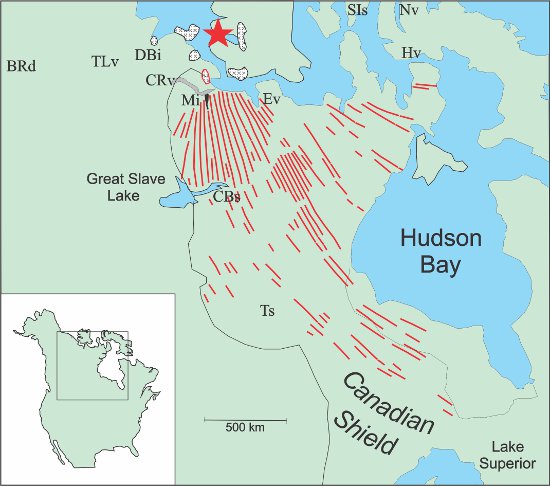
Figure 1: Map of the Mackenzie large igneous province, including the Mackenzie dykes and Coppermine Volcanics continental flood basalts and location of the Muskox intrusion, with approximate focal point for ~1.27 Ga igneous activity (star) and the large positive gravity anomalies (in cross hatched patterns) interpreted as intrusions, including a gravity anomaly linked to the Muskox intrusion (outlined in red; from Baragar et al., 1996). Abbreviations are: BRd = Bear River dykes, CBs = Christie Bay sills, CRv = Coppermine River volcanics, DBi = Darnley Bay intrusion, Ev =Ekalulia volcanics, Hv = Hansen volcanics, Mi = Muskox intrusion, Nv = Nauyat volcanics, SIs = Somerset Island sills, TLv = Tweed Lake volcanics, Ts = Tremblay sills. After unpublished diagram courtesy of R.E. Ernst and K.L. Buchan (2008) modified after Buchan and Ernst (2004).
The Mackenzie dykes fan out in a radial array (~100º of arc) that extends more than 2400 km along strike and has a maximum width of 1800 km before becoming buried under younger cover rocks. The dykes are generally tholeiitic, although more alkalic compositions occur in the easterly stream the dyke swarm. On average, the dykes become increasingly evolved with distance from the focal point, possibly due to crystal settling during lateral magma transport, but also possibly due to later magmas being more evolved (due to source chamber processes), and emplaced for a greater distance due to greater magmatic head, resulting from progressive uplift in the source region (Baragar et al., 1996). The Mackenzie dykes generally lack olivine, apart from diabase in the Lake Athabasca region (~1500 km from the focal point) that comprise both olivine-bearing and olivine-free dolerites (Hulbert et al., 1993), although the olivine-bearing magma at this distance may be Keweenawan-aged (pers. comm.. R. Ernst, 2008; see 1108 Ma age date in French et al., 2002). Although the Mackenzie dykes average 30 m in thickness, many are up to 150 m thick and are characterized by coarse-grained gabbroic centers and well-defined chilled margins. The northernmost dykes of the swarm terminate within the lower flows of the Coppermine CFB indicating that some of the dykes acted as feeders to some of the flows. Anisotropy of magnetic susceptibility (AMS) data for the Mackenzie dykes indicate near-vertical flow at sites 400-500 km from the focal point at northern Victoria Island and horizontal flow at >600 km (Ernst and Baragar, 1992), indicating common derivation for the Mackenzie dykes within a ~1000 km radius of the focal point. U-Pb baddeleyite dating of selected Mackenzie dykes from an array of distances from the assigned focal point give a composite Concordia age of 1267±2 Ma (LeCheminant and Heaman, 1989), establishing that the entire Mackenzie magmatic event was essentially emplaced contemporaneously throughout its enormous geographical extent.
Combined geophysical evidence that substantial volumes of the Coppermine CFB and Muskox intrusion are covered by Palaeozoic strata (Fig. 1) implies that the Mackenzie magmatic event likely represents one of the largest LIPs in the geological record.
The Muskox Layered Mafic-Ultramafic Intrusion
Understanding the evolution of LIPs requires careful examination of the plumbing system through which their magmas were processed. Layered intrusions have been central for addressing this issue, because they record periods of magmatic activity intimately associated with their LIP. Several characteristics of the Muskox layered intrusion make it highly suited to the study of the magmatic plumbing system of the Mackenzie LIP. First, it is one of the oldest components of the LIP and is well-developed and structurally undeformed, featuring a complete rock differentiation series from dunite cumulates, peridotites, pyroxenites, and gabbros, through to granophyres (Fig. 2). Second, it is one of the most ultramafic large layered intrusions so far recognized on Earth, and is considered to be related in space and time to the 1.27 Ga giant Mackenzie dyke swarm and Coppermine CFB (Baragar 1969; Francis, 1994; Baragar et al., 1996).
Here, I summarize the results of a geochemical study by Day et al. (2008) in which they considered the effects of magma chamber processes (assimilation, magma-mixing through recharge) on modification of mantle-derived melts, the generation of chromitite horizons in the layered intrusion and examined the origin and possible effects of secondary hydrothermal processes on the distribution of platinum-group element (PGE) horizons in the intrusion. In this contribution I focus on the implications of this study on constraining the isotopic composition of the mantle source of the Mackenzie LIP, and the importance of understanding the magmatic plumbing system beneath LIPs.
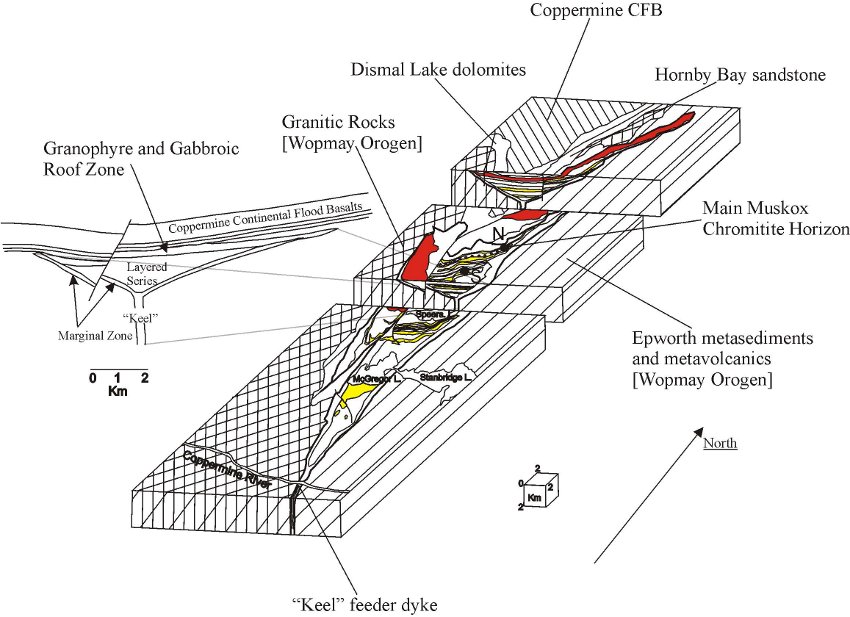
Figure 2: Exploded block diagram of the Muskox intrusion, showing its structural relations with country rocks, including >1.8 Ga Wopmay Orogen rocks, 1.66 Ga Hornby Bay sandstone and younger dismal lake dolomites. Also shown is a restored cross-section of the exposed portions of the intrusion and the location of the North (North DDH) and South (South DDH) diamond drill-holes (modified from Irvine and Smith, 1967 and Irvine, 1980). Red units denote roof zone rocks and yellow units denote approximate locations of major cyclic units within the intrusion. Stanbridge (StL), McGregor (ML) and Speers (SL) lakes also shown.
The Muskox intrusion was emplaced into the Aphebian basement complex of >1.8 Ga Wopmay para- and ortho-gneiss, metavolcanics and metasediments at the base of the 3-5º north-ward dipping Helikian sequence - the so-called Coppermine Homocline (Hofmann, 1980; Kerans et al., 1981). The overall structure of the intrusion is that of a giant funnel-shaped dyke (~125 km long, 11 km wide in the north, and 0.1 km wide in the south) that merges into a vertical dyke extending to the south, known as the Keel feeder dyke (Fig. 2). Aeromagnetic and gravity anomaly studies indicate the intrusion extends northward for at least 250 km under younger cover where it becomes more laterally extensive (Fig. 1). The intrusion can be divided into a feeder dyke, two marginal zones (east and west), a layered series composed entirely of cumulates, and a granophyric roof zone (Irvine, 1980). Twenty-five cyclic units have been identified within the layered series (Findlay and Smith, 1965; Irvine and Smith, 1967), which have been interpreted as individual replenishment episodes of mantle-derived mafic magma. Two thin (<10 cm) main stratiform chromitite horizons occur in the intrusion, in the middle of cyclic unit 21 and at the base of cyclic unit 22. In addition to these horizons, a laterally discontinuous lower chromitite layer has been inferred based on cryptic chemical variations, which is termed here as the ‘Hulbert Reef’ (DDH-MX-S137).
The layered series of the Muskox intrusion are cumulate rocks, and as such, the minerals they accumulate dominantly control their major and trace element compositions (Fig. 3). Mafic-ultramafic layers in the Muskox intrusion have low absolute incompatible trace element abundances and, when combined with compatible element variations, reflect the role of olivine and chromite accumulation in the intrusion, as well as replenishment of new batches of magma to form the observed cyclic units. Calculated initial Nd isotope (εNdi) values (-0.1 to -6.6) are in agreement with previous whole-rock analyses of layered series rocks (Stewart and DePaolo, 1996), and can be explained by significant crustal contamination in roof- and marginal-zone rocks and the low rare earth element abundances in layered series rocks, making them highly sensitive to even minor crustal disturbance (Country rocks have εNd1270 Ma = -20.3 to -22; Stewart and DePaolo, 1996). Abundances of highly siderophile elements (HSE) are variable throughout the intrusion, with a similar range of abundances for Os, Ir and Ru (the Ir-platinum group elements (PGE)) but more variable ranges in Pt, Pd and Re (the Pt-PGE and Re).
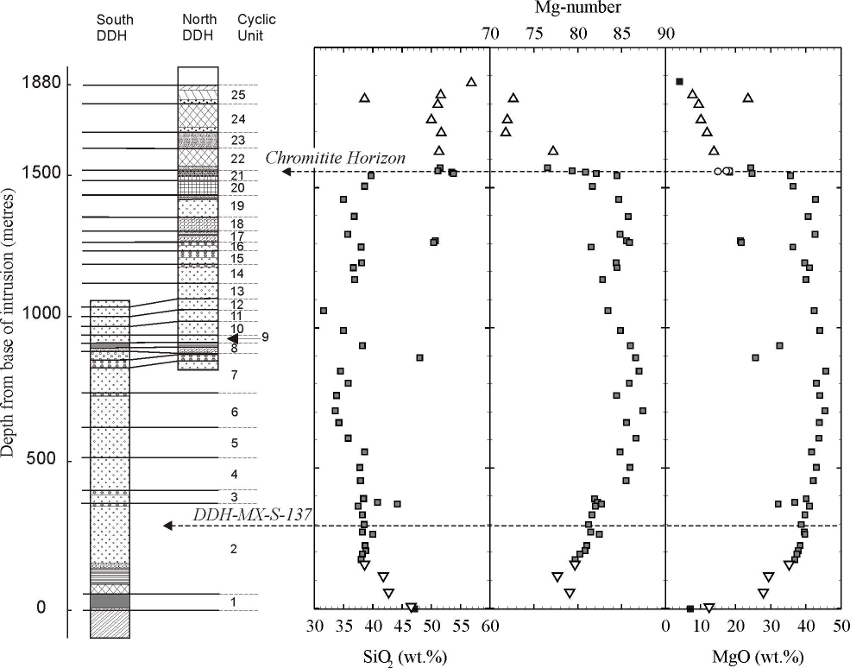
Figure 3: Variation of major elements (corrected to anhydrous proportions) with depth from the base of the Muskox intrusion. The intrusion is dominantly composed of dunites and peridotites, with a 300 m roof zone (also known as the upper border zone) predominantly composed of silica-rich granophyres. Country rocks are shown as solid squares, the roof zone (~1550 m to 1880 m) and marginal zone (0 to ~200 m) as unfilled triangles and the layered series as grey squares.
Ir-PGE in the silicate rocks correlate with Cr and Ni indicating their compatibility during fractional crystallization. There is overall agreement between the isotope dilution HSE data of Day et al. (2008) with that of the NiS-INAA dataset of Barnes and Francis (1995), and these data show the strong control of sulfide, especially for the marginal zone samples and country rocks. Base metal sulfide (BMS) liquid, which has extremely high affinity for the HSE, likely played an important role in the distribution of these elements in the marginal zones of the intrusion, with layered series rocks showing less dependence on this process.
Measured 187Os/188Os for the Muskox intrusion and keel dyke samples are slightly sub-chondritic to highly radiogenic (0.1228 to 2.93). Initial Os isotope compositions (γOsi ; age corrected to 1270 Ma) are in excess of chondritic values for all layered series peridotites and span a large range (+1.2 to +86.5), showing oscillating variation with stratigraphic height and more positive γOsi values progressively up the layered series succession. The lowest measured δ18O values (~5.5‰) of silicate minerals lie within the range of values typically observed in mantle peridotites (Mattey et al., 1994).
Day et al. (2008) showed that some of the Os isotopic heterogeneity seen in the data set can be explained through hydrothermal alteration and mobilization of Re in the intrusion, but that many of the samples were unaffected by alteration and instead, retained the isotopic heterogeneity generated through crustal assimilation and fractional crystallization processes (Fig. 4). Estimates of crustal assimilation indicate that the layered series are significantly less contaminated (<4% assimilation) than most of the marginal and roof zone rocks. Hence, layered series rocks, along with the Keel dyke, offer the most potential for constraining the isotopic characteristics of the Muskox intrusion parental melt. Day et al. (2008) used these least contaminated samples to estimate that primitive Muskox intrusion magmas had chondritic to slightly supra-chondritic Os and Nd isotope compositions and O isotope compositions close to that of upper mantle peridotite nodules. Assuming a primitive magma composition of ~13-15 wt.% MgO (Francis, 1994) the calculated initial parental magma composition for the Muskox Intrusion has 0.5-1.1 ng/g Os, 0.4-0.8 ng/g Ir, 5.0-5.9 ng/g Ru, 11.8-14.2 ng/g Pt, 19.0-20.7 ng/g Pd and 0.5 ng/g Re. The estimated initial melt compositions values for Mackenzie LIP magmas are consistent with >15% partial melting and a lack of residual sulfide in the mantle source.
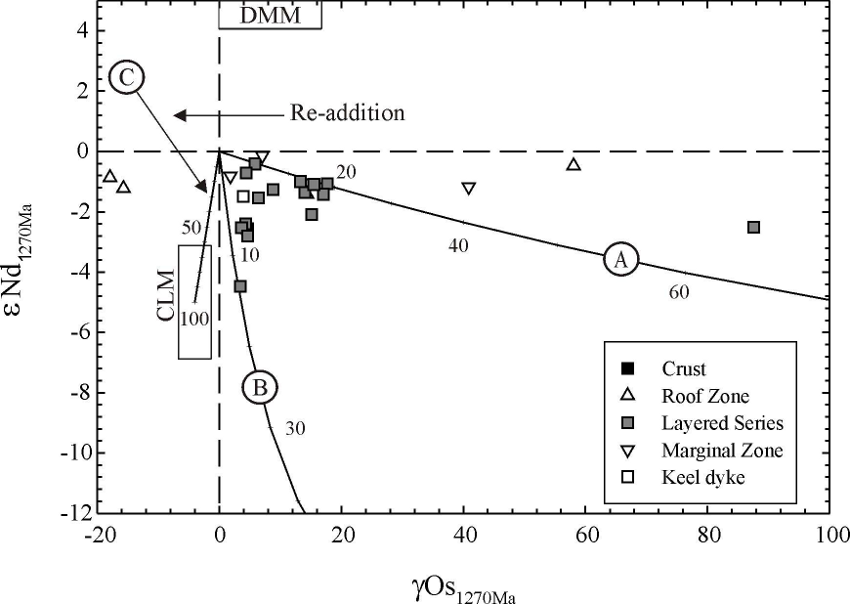
Figure 4: εNd(1270 Ma) versus γOs(1270 Ma) diagram illustrating the effects of crustal contamination on the isotopic composition of Muskox intrusion rocks. Primary magma composition assumes [Nd] = 30 ppm, [Os] = 1 ppb, and broadly chondritic εNd and γOs. Binary mixing curves between primary magma and; A - Wopmay paragneiss [Nd] = 11.2 ppm, [Os] = 0.2 ppb, εNd = -8.7, γOs = 240; B - Granitic and sedimentary country rock [Nd] = 50 ppm, [Os] = 0.05 ppb, εNd = -20, γOs = 400; C - continental lithospheric mantle (CLM) melts, which are assumed to have identical Nd and Os abundances to the primary magma and εNd = -5, γOs = -4. Fractional crystallization plays a fundamental role in the distribution of different elements in cumulate and evolved magmas, such that mixing curves will not be unique. For example, higher [Nd] or lower [Os] will result in strongly convex curves for mixing model A and concave curves for low [Nd] or high [Os] abundances in primary magma relative to the crustal assimilant. Values for crust and CLM can be found in Day et al. (2008). Marks along the curves denote 10% increments of crustal addition. A number of marginal and roof zone samples lie to extremely negative γOs because of post-magmatic Re-addition. For the Muskox intrusion there is no evidence of CLM melting to source magmatism suggesting that the Mackenzie LIP was almost exclusively sourced from the asthenospheric mantle.
Implications for magmatism in LIPs
Crustal assimilation and magma chamber processes can fully account for the range of Os and Nd isotope compositions of Muskox intrusion rocks. Least contaminated samples yield γOsi close to chondritic values and δ18O similar to modern-day mantle rocks. Furthermore regressions of HSE data indicate melting of an undepleted mantle source. The chondritic to slightly radiogenic γOsi and εNdi values of Muskox parental melts implies a convecting mantle source for the portion of the Mackenzie LIP event represented by the Muskox intrusion, as previously suggested by Stewart and DePaolo (1996). The estimated Muskox intrusion parental melt composition is plotted versus time in Fig. 5 together with the averages of ophiolite chromitites, abyssal peridotites, komatiites, carbonaceous, enstatite, and ordinary chondrites, estimates for primitive upper mantle from global studies of mantle xenoliths, and the solar system initial (SSI). A large number of layered intrusions and LIPs deviate from the chondritic evolution line to more radiogenic 187Os/188Os, suggesting a supra-chondritic Re/Os source. However, many of these layered intrusions (and associated CFB) are either likely to have been, or are demonstrably, contaminated with crustal material and therefore their use in delineating the PUM mantle evolution curve is contentious. A regression line through SSI and the Mackenzie LIP source intersects the present-day at 187Os/188Os = 0.1296±0.0071, in agreement with PUM estimates (0.1296±0.0008; Meisel et al., 2001). This requires that the source of the Mackenzie LIP evolved with 187Re/188Os similar to that of PUM.
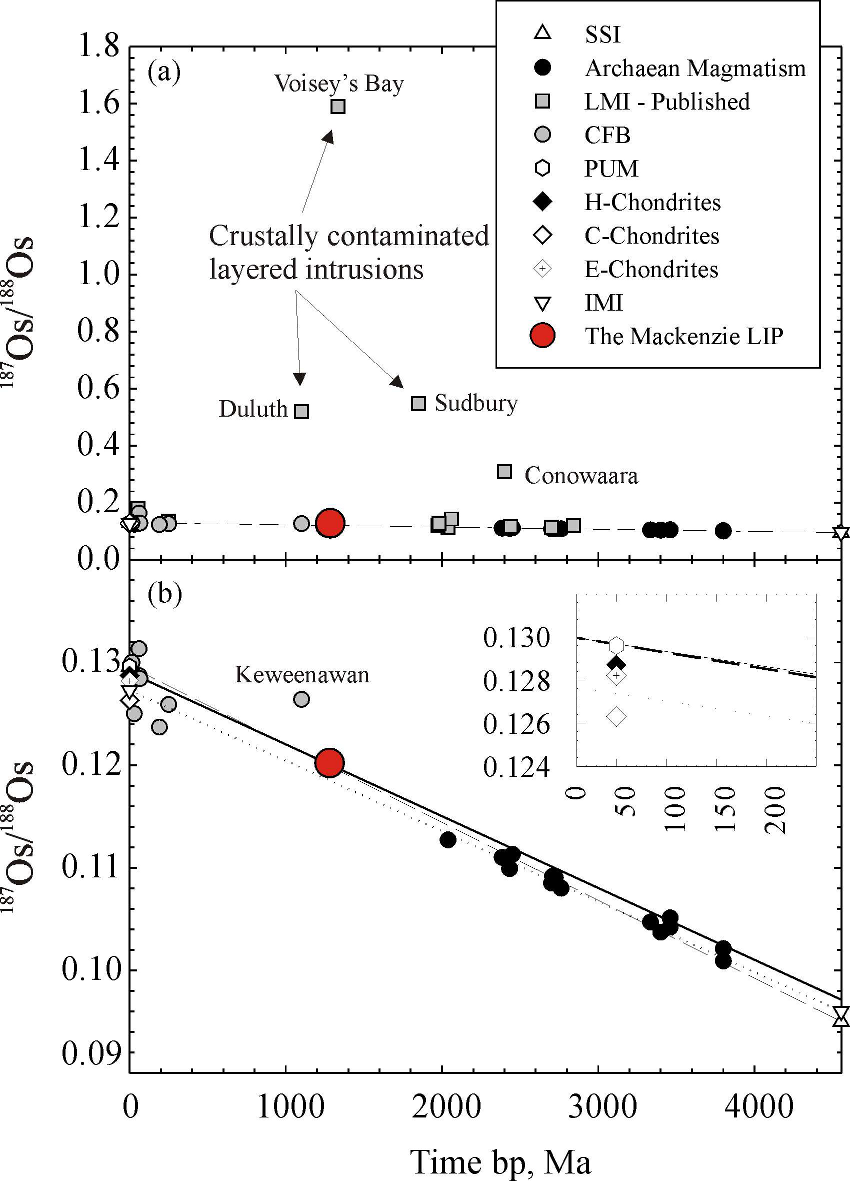
Figure 5: Evolution diagram of 187Os/188Os vs. time before present (in Ma) for selected mantle-derived materials, chondrites, solar system initial (SSI) and iron meteorite initial (IMI). (a) Dashed line represents regression line through SSI (Shirey and Walker, 1998) and that of the Mackenzie LIP source. (b) Crustally contaminated LMI and CFB removed from plot, dotted line is IMI composition regression and dashed line is SSI composition regression. Mackenzie LIP show Keel (+1.2) and Layered Series (+0) initial γOs. These models indicate that chondritic 187Os/188Os compositions have been a feature of the mantle source for intraplate magmatism and mantle-derived melts for at least 3.8 Ga (Bennett et al., 2002), until at least the mid-Proterozoic. Keweenawan samples appear anomalous and are associated with the demonstrably crustally contaminated Duluth intrusion so they have been excluded in the lower plot. Data sources can be found in Day et al. (2008). LMI = Layered Mafic Intrusions; CFB = Continental Flood Basalts; PUM = Primitive Upper Mantle.
Geochemical variations in the Muskox Intrusion highlight the importance of crustal assimilation processes at all levels within continental intraplate magmatic systems. There is a dynamic interplay between magma plumbing systems, preserved as mafic intrusions, sills and dykes, with dyke swarms and CFB (e.g., Baragar et al., 1996; Ernst & Buchan, 1997). In the case of the Muskox intrusion, it is possible to “see through” the effects of crustal contamination and magma chamber processes, allowing estimation of the source composition of magmas feeding the Mackenzie LIP. The observation of an undepleted asthenospheric mantle source for the Muskox Intrusion is consistent with the notion of an anomalous mantle upwelling model for the generation of the Mackenzie LIP. The large volume of magma produced during the relatively short period of time measured for the Mackenzie LIP (LeCheminant and Heaman, 1989), the high degrees of partial melting (>15%), the presence of high MgO and Mg/Fe lavas in the early phases of magmatism (Day, 2004), the uplift/subsidence history, and the topographic drainage and gravity structure of the region (Baragar et al., 1996), which coincides with the focal point of Mackenzie dyke propagation (Ernst and Baragar, 1992) all appear to indicate anomalous mantle melting, possibly related to failed rifting (Fahrig, 1987). The source for Mackenzie LIP and Muskox Intrusion parental magmas therefore appears to be derived from a region of mantle that has not previously witnessed significant melt extraction, and is consistent with the concept of a deep mantle upwelling or mantle plume beneath the Canadian Shield during the mid-Proterozoic.
Acknowledgements
The author thanks Graham Pearson and Larry Hulbert for their support during all aspects of this project and Richard Ernst for his comments on this contribution. This study was conducted as part of a Natural Environment Research Council (UK) funded PhD scholarship (University of Durham, UK), a Society of Economic Geologists Canada Foundation Award, and the Edgar Pam Fellowship (Institute of Material, Minerals and Mining, UK).
References
Baragar W.R.A. (1969). The geochemistry of the Coppermine River basalts. Geological Survey of Canada Paper, 69-44, 43pp.
Baragar W.R.A., Ernst R.E., Hulbert L. & Peterson T. (1996). Longitudinal petrochemical variation in the Mackenzie dyke swarm, Northwestern Canadian Shield. Journal of Petrology, 37, 317-359.
Barnes S.-J. & Francis D. (1995). The distribution of platinum-group elements, nickel, copper, and gold in the Muskox layered intrusion, Northwest Territories, Canada, Economic Geology, 90, 135-154.
Bennett V.C., Nutman A.P. & Esat T.M. (2002). Constraints on mantle evolution from 187Os/188Os isotopic compositions of Archaean ultramafic rocks from southern West Greenland (3.8Ga) and Western Australia (3.46Ga). Geochimica et Cosmochimica Acta, 66, 2615-2630.
Buchan, K.L. & Ernst, R.E. (2004). Diabase dyke swarms and related units in Canada and adjacent regions. Geological Survey of Canada Map 2022A, with map 1:5,000,000 and accompanying notes.
Bryan, S.E. & Ernst, R.E. (2008). Revised definition of Large Igneous Provinces (LIPs). Earth-Science Reviews, 86, 175-202.
Coffin, M.F. & Eldholm, O. (1994). Large igneous provinces: crustal structure, dimensions, and external consequences. Reviews of Geophysics, 32, 1-36.
Coffin, M.F. & Eldholm, O. (2005). Large igneous provinces. In: Encyclopedia of Geology. Edited by R.C. Selley, L.R.M. Cocks & I.R. Plimer. Elsevier, Oxford, pp. 315-323.
Day J.M.D. (2004) A helium, oxygen and rhenium-osmium isotope study of some intraplate magmatism. PhD thesis, Durham, UK, University of Durham, 430pp.
Day J.M.D., Pearson D.G. & Hulbert L.J. (2008) Rhenium-osmium and platinum-group element constraints on the origin and evolution of the 1.27 Ga Muskox layered intrusion. Journal of Petrology, 49, 1255-1295.
Ernst R.E. & Baragar W.R.A. (1992). Evidence form magnetic fabric for the flow pattern of magma in the Mackenzie giant radiating dyke swarm. Nature, 356, 511-513.
Ernst R.E. & Buchan K.L. (1997) Layered mafic intrusions: a model for their feeder systems and relationship with giant dyke swarms and mantle plume centres. South African Journal of Geology, 100, 319-334.
Ernst R.E., Head J.W., Parfitt E., Grosfils E. & Wilson L. (1995). Giant radiating dyke swarms on Earth and Venus. Earth Science Reviews, 39, 1-58.
Fahrig W.F. (1987). The tectonic settings of continental mafic dyke swarms: failed arm and early passive margin. In: H.C. Halls, W.F. Fahrig (Eds.) Mafic Dyke Swarms. Geological Association of Canada Special Paper, 34, 331-348.
Findlay D.C. & Smith C.H. (1965). The Muskox Drilling Project. Geological Survey of Canada paper, 64-44, 170pp.
Fitton J.G., Mahoney J.J., Wallace P.J. & Saunders A.D. (Eds.) (2004) Origin and evolution of the Ontong-Java plateau. Special publication of the Geological Society of London, 229, 368pp.
Francis D. (1994). Chemical interaction between picritic magmas and upper crust along the margins of the Muskox intrusion, Northwest Territories. Geological Survey of Canada Paper, 92-12, 94pp.
French J.E., Heaman L.M. & Chacko T. (2002). Feasibility of chemical U-Th-total Pb baddeleyite dating by electron microprobe. Chemical Geology, 188, 85-104.
Hofmann P.F. (1980). Wopmay orogen: a Wilson cycle of Early Proterozoic age in the northwest of the Canadian Shield. In: D.W. Strangway (Ed.) The continental crust and its mineral deposits. Geological Association of Canada Special Paper, 20, 523-552.
Hulbert L., Williamson B. & Theriautt R. (1993) Geology of middle Proterozoic Mackenzie diabase suites from Saskatchewan: an overview and their potential to host Noril’sk-type Ni-Cu-PGE mineralization. Saskatchewan Energy and Mines Miscellaneous Report. 93-4, 112-126.
Irvine T.N. (1980). Magmatic infiltration metasomatism, double-diffusive fractional crystallization, and adcumulus growth in the Muskox intrusion and other layered intrusions. In: R.B. Hargreaves (Ed.) Physics of magmatic processes. Princeton University Press. Pp. 325-383.
Irvine T.N. & Smith C.H. (1967) The ultramafic rocks of the Muskox intrusion. In: Wyllie P.J. (Ed.) Ultramafic and related rocks. John Wiley and Sons, Inc. Pp. 20-38.
Kerans C., Ross G.M., Donaldson J.A. & Geldsetzer H.J. (1981). Tectonism and depositional history of the Helikian Hornby Bay and Dismal Lake Groups, District of Mackenzie. In: F.H.A. Campbell (Ed.) Proterozoic Basins of Canada. Geological Survey of Canada, Paper 81-10, 157-182.
LeCheminant A.N. & Heaman L.M. (1989). Mackenzie igneous events, Canada: Middle Proterozoic hotspot magmatism associated with ocean opening. Earth and Planetary Science Letters, 96, 38-48.
Mattey D.P., Lowry D. & Macpherson C. (1994). Oxygen isotope composition of mantle peridotite. Earth and Planetary Science Letters, 128, 231-241.
Meisel T., Walker R.J., Irving A.J. &d Lorand J.-P. (2001). Osmium isotopic compositions of mantle xenoliths: a global perspective. Geochimica et Cosmochimica Acta, 65, 1311-1323.
Shirey S.B. & Walker R.J. (1998). The Re-Os isotope system in cosmochemistry and high-temperature geochemistry. Annual Reviews in Earth and Planetary Science, 26, 423-500.
Stewart B.W. & DePaolo D.J. (1996). Isotopic studies of processes in mafic magma chambers: III. The Muskox intrusion, Northwest Territories, Canada. In: A. Basu, S. Hart (Eds.) Earth Processes: Reading the Isotopic Code. AGU Geophysical Monograph, 95, 277-292.
